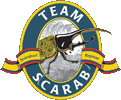.
| .... |
| |
| The family Scarabaeidae has about 35,000 species, and Dynastinae is the most charismatic subfamily consisting of about 1,400 species. Most are found in the Neotropics. Adults are small (4 mm) to huge (160 mm). Males often possess extravagant horns that have given rise to names such as rhinoceros, atlas, or hercules beetles. Adults of most species are nocturnal and attracted to lights and feed on rotting fruit, sap, and plant roots. Some are pollinators of palms and aroids. Larvae are saprophagous or phytophagous and live in the soil or decaying logs where they are important in nutrient cycling. The immature stages and natural history for most species remain unknown. Larvae take from 1-3 years to develop, and adults live for several weeks. |
| |
|
 |
Collaborators Aura Paucar-Cabrera
and Ronald Cave at the collections of the Catholic University of Quito (QCAZ).
Photo by B. Ratcliffe. |
|
Ecuador, like many countries in the tropics, is biotically megadiverse and is at risk from deforestation, environmental homogenization, pollution, invasive species, and urban sprawl, all brought on by expanding human populations. This research will promote discovery and reveal new knowledge about a group of beetles important in ecosystem ecology and agriculture. The principal investigators for this project are Brett Ratcliffe (University of Nebraska), Ron Cave (University of Florida), and Aura Paucar-Cabrera who is the in-country collaborator and lives in southern Ecuador. The project's principal objectives are to coordinate with Ecuadorian scientists, students, collections managers, and parks officials to explore, discover, and document the biodiversity of dynastine scarab beetles in Ecuador. |
| |
 |
Golofa eacus, a large rhinoceros beetle found at Podocarpus National Park, Ecuador.
Photo by R. Cave. |
|
The goals are:
(1) discover and describe new species,
(2) establish habitat associations and distributions in space and time for all species,
(3) authoritatively identify, curate, and augment research collections, and
(4) disseminate research results in print and electronically to a worldwide community of researchers, students, natural resource managers, government entities, amateur naturalists, and the public. |
| |
 |
Ecuador is a small country but with huge biodiversity
due to intact tropical forests as here at Podocarpus National Park.
Photo by B. Ratcliffe. |
| |
| |
| |
| |
 |
Light traps set in the jungle are our primary way of collecting nocturnal rhinoceros beetles.
Photo by B. Garner. |
| |
|
Ecuador contains 42 genera (46% of the New World dynastine genera) and is one of 25 global Biodiversity Hotspots where exceptional concentrations of biodiversity are undergoing rapid loss of habitat. The 25 hotspots comprise only 1.4% of the land surface of the Earth, but they contain the sole remaining habitats of 44% of the Earth's vascular plant species and 35% of its vertebrate species, and, by extension, sizeable numbers of insects as well (Myers et al. 2000). The study area is a complex region where Andean and Amazonian biomes converge. The insect fauna of this area is exceptionally rich because of the influence of vastly varied topography and microclimates. In no other part of the world is the insect fauna of high mountains (above 2000 m) as different from that of the contiguous Amazonian lowlands as in western South America. The broken topography has produced the region's own unique species resulting in some of the highest levels of diversity and endemism on Earth (Mittermeier et al. 1999). Our rational use of natural resources depends on accurate ecological knowledge, but the major deterrent to ecological studies is the lack of taxonomic data that is fundamental for all subsequent studies. In order to arrive at a sound view of ecology in the tropics, we must first identify and catalog the fauna. Helping us in this endeavor is the US National Collection of scarabs (250,000 specimens) that we transferred from the Smithsonian Institution to the Team Scarab lab at the University of Nebraska several years ago for off-site enhancement. |
| |
 |
Museum collections contain vast amounts of biodiversity information, and access to this information is critical to planning future research and conservation efforts.
Photo by R. Cave. |
| |
 |
Curator of Entomology Brett Ratcliffe in Ecuador.
Photo by R. Cave. |
| |
|
Documenting life on Earth is a primary responsibility of taxonomists, and taxonomic monographs are cornerstones of comparative biology. The users of these data are scientists and students studying their fauna; ecologists needing identifications and information on biology and distribution; museum professionals responsible for organizing research collections; biogeographers needing distributional data; the agro-industry for information on invasive species and pests; park and reserve managers needing to know the faunal composition of their areas of responsibility for establishing management plans, educational programs, or research opportunities; and government entities needing baseline data for conservation planning. Ed Wilson (2004) observed that descriptive taxonomy is our pioneering exploration of life on Earth, and that among its cascade of derivative functions it lays the foundation for the phylogenetic tree of life, provides a requisite database for ecology and conservation science, and makes accessible the vast and still largely unused benefits offered by biodiversity to humanity. We are continuing to build that foundation. |
| |
| |
| |
References
Mittermeier, R. A., N. Myers, and G. Mittermeier. 1999. Hotspots. Earth's Biologically Richest and Most Endangered Terrestrial Ecoregions. CEMEX, Mexico City, Mexico. 430 pp.
Myers, N., R. A. Mittermeier, C. G. Mittermeier, G. A. B. da Fonseca, and J. Kent. 2000. Biodiversity hotspots for conservation priorities. Nature 403: 853–858.
Wilson, E. O. 2004. Taxonomy as a fundamental discipline. Philosophical Transactions of the Royal Society B (Biological Sciences) 359: 739. |
| |
|
.... |
. |



